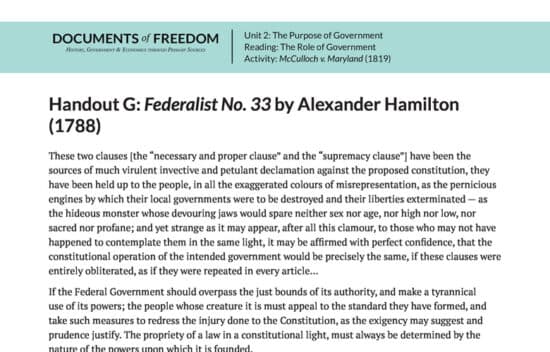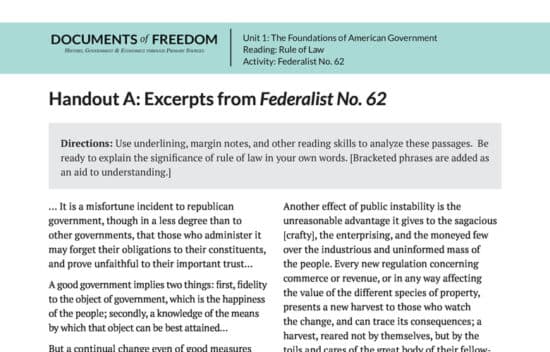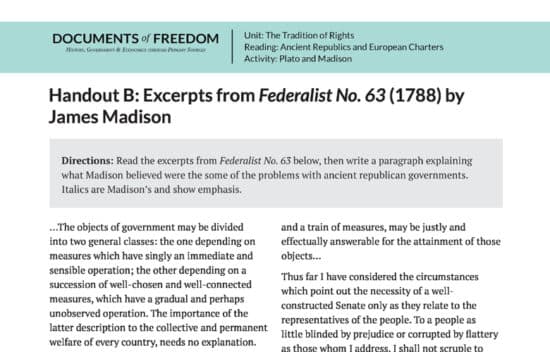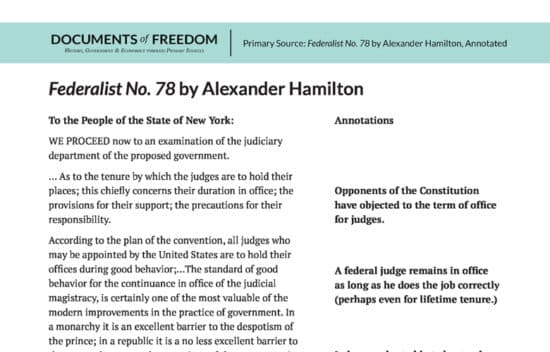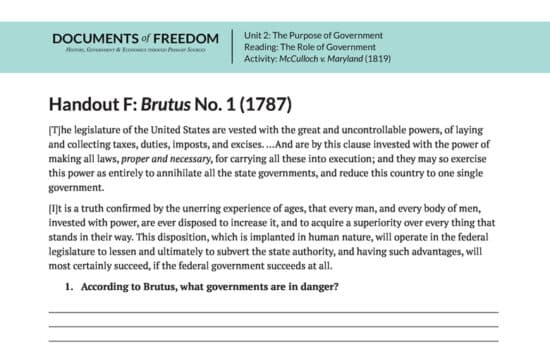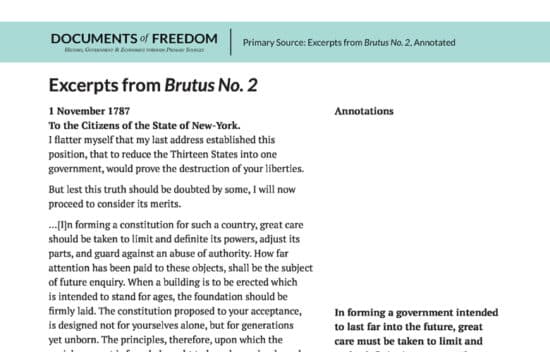



Federalist and Anti-Federalist Papers
42 items
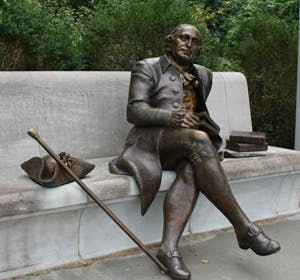
The Ratification Debate
Lesson - 11 Activities
Lesson
11 Activities
80 Min
After the Constitution was completed and signed by 39 delegates on September 17, 1787, many of the debates from Independence Hall continued in the debates over ratification in the states. For the Constitution to go into effect, at least nine states would have to ratify (or agree to adopt) it. A party division arose: Federalists argued in favor of ratification, Anti-Federalists against. Leading Federalists James Madison and Alexander Hamilton made a case for ratification in the Federalist Papers. Leading Anti-Federalists were Patrick Henry and George Mason. Mason had attended the Convention but refused to sign the final document, arguing that the central government created by the Constitution would be a threat to liberty and would take away power from the individual states.
80 Min

The Ratification Debate on the Constitution
Essay - 3192 Words
Essay
3192 Words
Why were some Americans opposed to the Constitution?
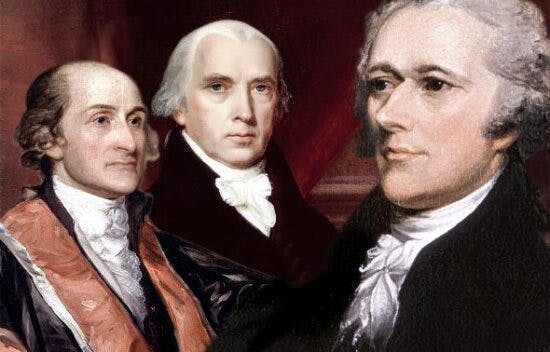
Federalist Papers
Collection
Collection
What are the Federalist Papers?
In order to help convince their fellow Americans of their view that the Constitution would not threaten freedom, James Madison, Alexander Hamilton, and John Jay teamed up in 1788 to write a series of essays in defense of the Constitution. The essays, which appeared in newspapers addressed to the people of the state of New York, are known as the Federalist Papers. They are regarded as one of the most authoritative sources on the meaning of the Constitution, including constitutional principles such as checks and balances, federalism, and separation of powers.
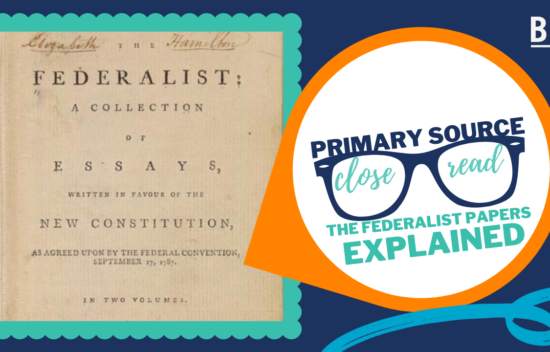
The Federalist Papers Explained | What Was the Argument to Ratify the U.S. Constitution?
Video
Video
21 Min
How are the Federalist Papers structured? In this episode of BRI’s Primary Source Close Reads, Kirk gives an overview of the papers that called on American citizens to support the ratification of the U.S. Constitution. What examples and explanations does Publius give as to why the Constitution must be ratified? What do these papers tell us about the design of the Constitution?
21 Min

Federalist 1 Explained | Alexander Hamilton’s Call for a Stronger U.S. Government
Video
Video
17 Min
What choice does Federalist 1 claim is before the people of the United States? In this episode of BRI’s Primary Source Close Reads, Kirk examines the first of the Federalist Papers and its call for a stronger constitution in the United States. What conversation is Publius setting up in this document through his rhetoric? What was the overall purpose of the Federalist Papers?
17 Min

Federalist 10
Primary Source - 3171 Words
Primary Source
3171 Words
Written by James Madison, this essay defended the form of republican government proposed by the Constitution. Critics of the Constitution argued that the proposed federal government was too large and would be unresponsive to the people.

Federalist 10 | BRI’s Primary Source Essentials
Video
Video
2 Min
How did Federalist 10 allow the Founders to create a Constitution with a stable and lasting form of government? In this rapid-fire episode of BRI’s Primary Source Essentials and Federalist 10 summary, learn the arguments from James Madison, who wrote Federalist 10. Discover why the Federalists believed a large republic was key to the Constitution and other Federalist 10 main points.
Primary Source Essentials Federalist 10 Handout: https://bri-docs.s3.amazonaws.com/PSE+Federalist+10+Handout.pdf
2 Min

The Effects of Factions: Federalist 10 Explained *Part 1* | A Primary Source Close Read w/ BRI
Video
Video
13 Min
How does the structure of our federal government promote the common good? In this video, Kirk Higgins analyzes Federalist 10 and what the author, James Madison, argues is the problem with factions in a democracy. What are factions? How can the Constitution limit the effects of factions?
13 Min

Public Good & Individual Rights: Federalist 10 Explained *Part 2* | A Primary Source Close Read
Video
Video
16 Min
How does the structure of our federal government promote the common good? This is one of the questions Kirk Higgins examines in part two of his analysis of James Madison’s Federalist 10. How can the government balance the competing interests of the public good and the rights of individual citizens? What constitutes a republican form of government? What makes a republican government work?
16 Min

Federalist 39
Primary Source - 2722 Words
Primary Source
2722 Words
Federalist No. 39, written by James Madison, is an explanation the character of the new republican system of government created under the Constitution. Madison explains why the United States government is partly national in character (meaning a government over a consolidation of all the states and the whole of the American people) as well as partly federal (a government over several sovereign states.)

Federalist 51
Primary Source - 2256 Words
Primary Source
2256 Words
In this Federalist Paper, James Madison explains and defends the checks and balances system in the Constitution. Each branch of government is framed so that its power checks the power of the other two branches; additionally, each branch of government is dependent on the people, who are the source of legitimate authority.

Balancing Ambition: Federalist 51 Explained *Part 1* | A Primary Source Close Read w/ BRI
Video
Video
12 Min
How does the structure of our federal system protect liberty? In part one of a two-part series, Kirk explains Federalist 51 in simple terms. How did the Founders set up a government that would balance power equally? Can personal motivations align with national interests while maintaining a balance of power in government?
12 Min
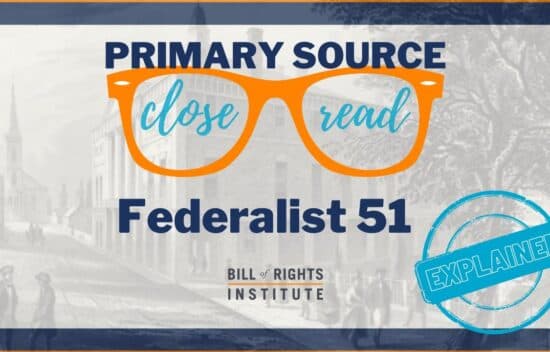
Balancing Interests: Federalist 51 Explained *Part 2* | A Primary Source Close Read w/ BRI
Video
Video
10 Min
How does the structure of our federal system protect liberty? In part 2 of our "Federalist 51 Explained" series, Kirk explores Publius' arguments for how the Constitution protects minority rights. How does the Constitution balance multiple interests to pursue the common good? What does it mean when Publius says that justice is the end of government?
10 Min

Federalist 51 | Primary Source Essentials
Video
Video
3 Min
What are the main Constitutional principles that help limit government? In this rapid-fire episode and Federalist 51 summary of BRI’s Primary Source Essentials, learn the arguments made by James Madison, who wrote Federalist 51, in Federalist 51. The Federalist 51 main points explain why he believed the constitutional checks and balances put in place would help create a limited government.
3 Min
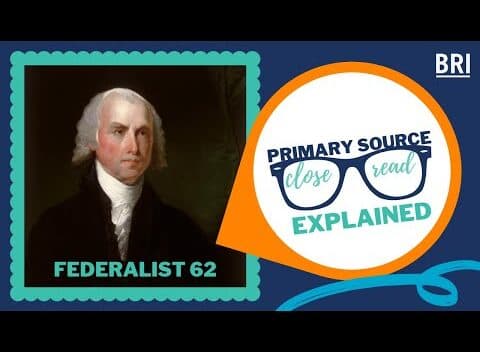
Federalist 62 Explained | What Is The Role Of The Senate?
Video
Video
21 Min
What does Federalist 62 tell us about the Senate? In this episode of BRI’s Primary Source Close Reads, Kirk gives an overview of Federalist 62 and the construction of the Senate. What role should the Senate serve according to Federalist 62? How does Publius argue the Senate will fulfill its role?
21 Min

Federalist 70
Primary Source - 3241 Words
Primary Source
3241 Words
In this Federalist Paper, Alexander Hamilton argues for a strong executive leader, as provided for by the Constitution, as opposed to the weak executive under the Articles of Confederation. He asserts, “energy in the executive is the leading character in the definition of good government.

Federalist 70 | Primary Source Essentials
Video
Video
2 Min
What were the essential characteristics of the executive branch according to Federalist 70? In this rapid-fire episode and Federalist 70 summary of BRI’s Primary Source Essentials, learn the arguments made by Alexander Hamilton, who wrote Federalist 70, in Federalist 70. Discover the Federalist 70 main points and why he believed in a strong executive branch to protect liberty and self-government.
2 Min
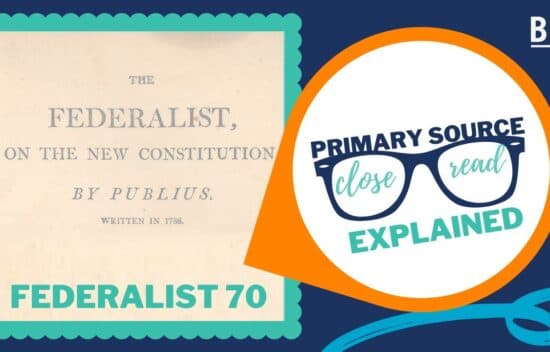
Federalist 70 Explained | Why Does the U.S. Have a Unitary Executive?
Video
Video
21 Min
Why does the Constitution call for a unitary executive? In this episode of BRI’s Primary Source Close Reads, Kirk looks at Federalist 70 and the debate between adopting a singular or plural executive. How does Publius argue that unity and energy are embodied in a unitary executive? How does the role of disagreement differ between the legislature and the executive?
21 Min

Federalist 78 | Primary Source Essentials
Video
Video
2 Min
What is the judiciary’s role in the American constitutional system according to Federalist 78? In this rapid-fire episode of BRI’s Primary Source Essentials and Federalist 78 summary, learn the arguments made by Alexander Hamilton in Federalist 78 and why he believed the judicial branch was the least dangerous and an essential part of the system of checks and balances.
2 Min

Federalist 84 Explained | What are Some Arguments Against the Bill of Rights?
Video
Video
21 Min
Did you know the Bill of Rights was not part of the original design of the Constitution and that many objected to it? In today's Close Read, Kirk dives into the arguments against a Bill of Rights in Federalist 84. Why did Publius believe that the Bill of Rights was unneeded and also could be dangerous?
21 Min

Would you have been a Federalist or an Anti-Federalist?
Page
Page
Federalist or Anti-Federalist? Over the next few months we will explore through a series of eLessons the debate over ratification of the United States Constitution as discussed in the Federalist and Anti-Federalist papers. We look forward to exploring this important debate with you! One of the great debates in American history was over the ratification […]

Federalist/Anti-Federalist Debate on Congress’s Powers of Taxation DBQ
Lesson - 1 Activities
Lesson
1 Activities
65 Min
Use this lesson with The Ratification Debate on the Constitution Narrative and the Were the Anti-Federalists Unduly Suspicious or Insightful Political Thinkers? Point-Counterpoint to have students analyze the debate between Federalists and Anti-Federalists.
65 Min
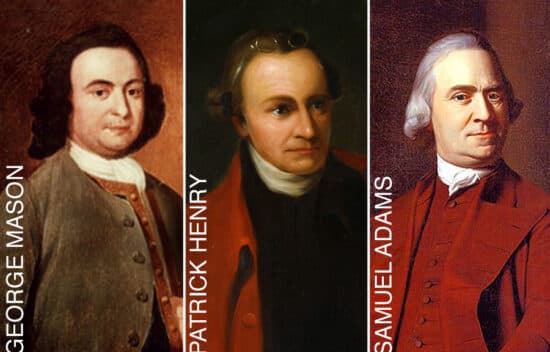
Were the Anti-Federalists Unduly Suspicious or Insightful Political Thinkers?
Activity
Activity
40 Min
The Anti-Federalists created significant challenges on the path of ratifying the Constitution. Were their concerns with the document unreasonable, or did they correctly foresee future problems that would arise in the new government? Gordon Lloyd and Adam Tate debate this question.

Brutus 1 Explained | What Elements of the Constitution Concerned the Anti-Federalists?
Video
Video
20 Min
What are Brutus’ main concerns about the new Constitution? In BRI’s Brutus 1 summary episode, Kirk looks at Brutus 1 and its critiques of the proposed US Constitution during the ratification debates. Why does Brutus feel a consolidated government will end liberty in opposition to the Federalist Papers? Why is he concerned about the creation of an expansive republic?
20 Min

Brutus 1 | BRI’s Primary Source Essentials
Video
Video
3 Min
Why did the Anti-Federalist so strongly oppose the proposed Constitution? In this rapid-fire episode of BRI’s Primary Source Essentials and Brutus 1 summary, learn the arguments made in Brutus 1 against the Constitution. Discover why the Anti-Federalists feared a large republic and other Brutus 1 main points.
Primary Source Essentials Brutus 1 Handout: https://bri-docs.s3.amazonaws.com/PSE+Brutus+1+handout.pdf
3 Min

Federal Farmer 1 Explained | What was the Federal Farmer’s Idea of Compromise for the Constitution?
Video
Video
23 Min
What were the Federal Farmer’s main concerns about the new Constitution? In this episode of BRI’s Primary Source Close Reads, Kirk examines another Anti-Federalist paper, Federal Farmer 1, and its many worries with the proposed US Constitution. Why is the Federal Farmer so concerned about consolidation? Why did the Federalists take this particular Anti-Federalist paper so seriously? What was the Federalist stance in the Federalist Papers?
23 Min


